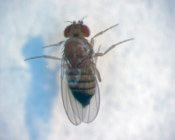Flies May Reveal Evolutionary Step to Live Birth
November 24, 2008
By Susan Brown
A species of fruit fly from the Seychelles Islands often lays larvae instead of eggs, UC San Diego biologists have discovered. Clues to how animals switch from laying eggs to live birth may be found in the well-studied species' ecology and genes.

On the verge: Drosophila yakuba sometimes lays eggs that have already hatched. Its genome may help to reveal how animals make the switch to live birth.
Credit: Drosophila Species Stock Center
The fly is one of a dozen species of Drosophila to have recently had their genomes sequenced, information that should provide abundant opportunities for identifying genetic changes that cause females of this species, and not others, to retain their fertilized eggs until they are ready to hatch.
The result was so surprising that the scientists initially thought it was a mistake.
"The student who was timing things came and said 'wow, these eggs in this species really develop quickly' sometimes in less than an hour. That's not possible," said Therese Markow, a professor of biology who led the project. "When I went and actually looked at them I saw that they were depositing something that was very advanced, that hatched into a larva right away. In several cases they were hatching as they were being laid."
Even those Seychelles fly eggs that emerged unhatched were at an advanced state of development, the team reports in forthcoming issue of the Journal of Evolutionary Biology. Most larvae emerged within two hours compared to an average of nearly 23 hours for the other 10 species in the study.
The Seychelles flies also laid larger eggs--nearly double the average volumes found for the other species--and their ovaries have fewer threadlike structures called ovarioles in which insect eggs mature before fertilization.
Live birth could result from changes to the male reproductive strategy as well. Proteins found in the semen of the well-known lab fruit fly, Drosophila melanogaster, stimulate egg laying in the female. A modification of these signals could be responsible for the switch.
"That signaling mechanism between the male and the female has changed. We don't know the basis for it, but we ought to be looking," Markow said. "It's very interesting. It tells you who's really going to be able control reproduction."
Early hatching offers advantages, the authors say. Mobile larvae can burrow into the ground to avoid becoming inadvertent hosts to the eggs of parasitic insects or a predator's meal. But harboring offspring for a longer period of time costs the female.
The opportunity to take that risk may come with specialization. The Seychelles flies feed only on the fruit of the morinda tree, a tropical plant that produces year round, but is toxic to other fruit flies, giving this single species exclusive access.
One other fly in the study, Drosophila yakuba, also occasionally laid larvae instead of eggs, and their eggs also hatched fairly quickly, most in under 14 hours. It too specializes in a particular fruit, that of the Pandanus tree.
The Seychelles flies, Drosophila sechellia and D. yakuba are two of about 250 species held by the Drosophila Species Stock Center , which moved to UC San Diego this fall.
Related Links- Therese Markow's Lab
- Drosophila Species Stock Center
- Contact: Therese Markow
